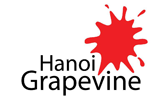Cristina NualART – Choe, Vietnam’s most Loved Truth Teller
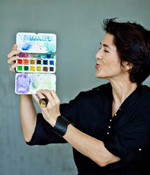
Cristina Nualart is a creative practitioner living in HCMC. She visits exhibitions and talks to artists and draws/paints/looks/thinks. The opinions she expresses come from her left brain, or her right brain, or her spilt guts, or the chip on her shoulder, or the heart on her sleeve.
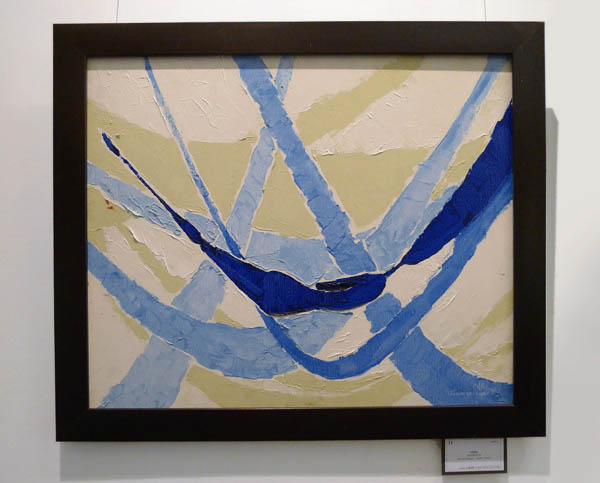
Thanks to our guest writer Cristina Nualart – a British Spanish artist based in Ho Chi Minh City, we are happy to post the review on exhibition “CHOE’S ARTWORKS”.
The septuagenarian couple that runs Tu Do gallery, the first commercial art gallery in South Vietnam, are still breaking ground in the local cultural landscape. They have just inaugurated a significant exhibition of artworks by Choe, one of the pen names of Nguyen Hai Chi.
The first acquisition made by husband and wife when they opened their gallery in 1989, was a series of twenty artworks by Choe. Some of those are now hanging next to works that belong to the private collection of the artist’s family. Although this retrospective is more thematic than comprehensive, it is worth visiting because many of these pictures are are not for sale and rarely shown publicly.
In the 1960s, very young still, Choe began to draw satirical illustrations for Saigon newspapers. He became a popular caricaturist very quickly, and a number of national and international newspapers printed his unflinching portrayals of political leaders, both Vietnamese and American. As well as cartoons, Choe also taught himself how to paint in oils and on silk, always creating strong figures. The strength of line in his silk paintings set him apart from other practitioners of this gentle medium.
Like Ho Chi Minh and other well known Vietnamese figures, the artist Nguyen Hai Chi changed his name when it suited him. Cap and Kit were other pen names he used. Choe means ‘mouse squeak’. Apparently he chose that nickname to express the irritation that his lampooning caricatures provoked in his critics. Larry Green, from theChicago Daily News, said that Choe was indeed as shy and quiet as a mouse, but he was ‘Vietnam’s most potent pen’¹. His incisive visual commentaries led him early on to have a monograph of his graphic work published in the US, The World of Choe, by Barry Hilton (1973). They also resulted in him being sent to a re-education camp in Vietnam several times.
It took Choe several years to pick up a pen after his second stint in prison. By then Vietnam was opening up to the world again, with the Doi Moi reforms. Choe pursued creative outlets like writing and music, and continued to paint and exhibit artworks. Although he was cautious not to inflame opinions as his self-confessed ‘reckless’ output had during earlier, turbulent times, Choe still gave visible form to a social critique that is otherwise sorely lacking in Vietnamese imagery.
Unfortunately this exhibition does not offer any of the witty newspaper work that made Choe famous. Many of the originals were destroyed during the war, but some reproductions can be seen here. Two series line one wall of the gallery: ’Visions of Summer’ is an unremarkable series of oil paintings, including Hammock (pictured above), which Choe created in France in the late 90s. There is a juicier body of illustrations, ‘Women of my country’, created for an exhibition in Japan in 1995. We get a sense of the potency of Choe’s pen with these spontaneously raw but carefully drawn watercolours that critique social evils like alcohol abuse, incompetent parenting, rote learning or deadweight husbands.
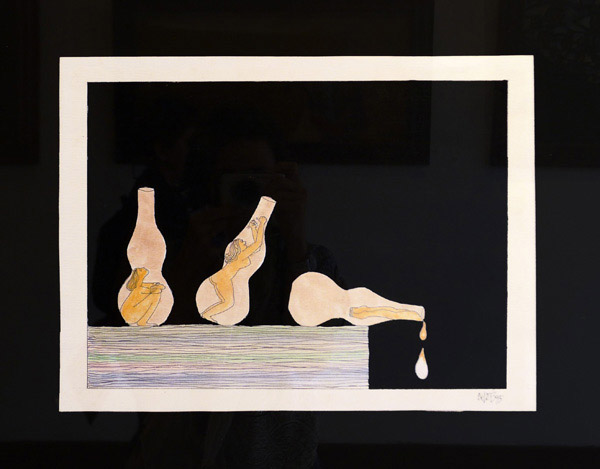
A clear comment on how alcoholism traps people and wastes their lives away.
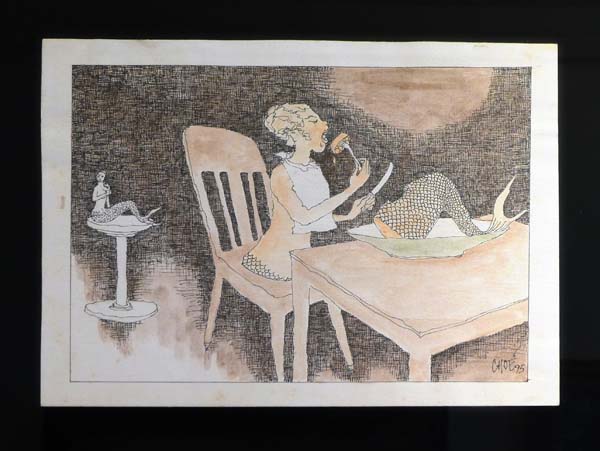
This curious image of an autophagic mermaid leaves me wondering. Is it a woman prepared to sacrifice herself for her family, as many do, or is it a woman who needs to draw from her own resources, and give everything she’s got just to keep her head above water? It could also be a feminist critique of the overconsumption of female bodies by the media, a propaganda so pervasive we all have to swallow it.
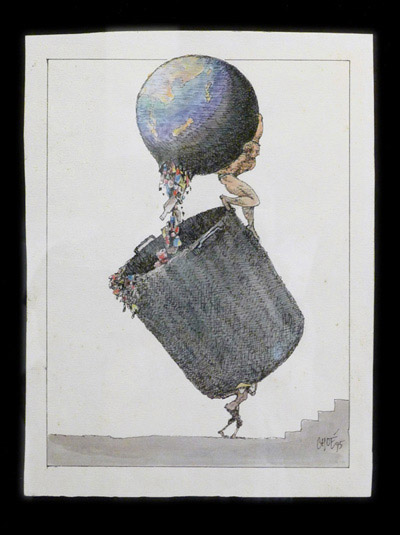
Many poor women in Vietnam, to survive, do for their city what a large proportion of women have to do for their households, get rid of the dirt and rubbish and clean up.

This tidy image in balmy colours is one of the rare critical messages from the Sauvigny Le Temple series of oil paintings. Choe painted this in France. The un-free man is chained to his desk, with in turn is chained to an invisible force outside of the left side of the image. Should we imagine that the chain is binding the person to a superior, a corporation, or to the West at large?
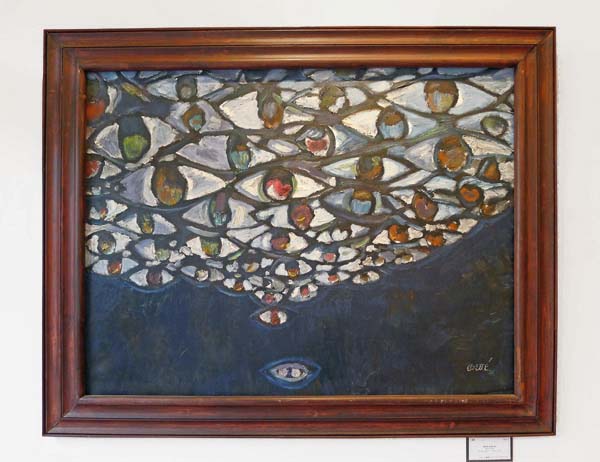
This is a stunning piece from the gallery’s own collection. References to Big Brother’s all seeing-eyes are not necessary. Vietnam’s own recent history has a strong record of breaches of human rights that allows the title alone to say all that is needed about this piece.
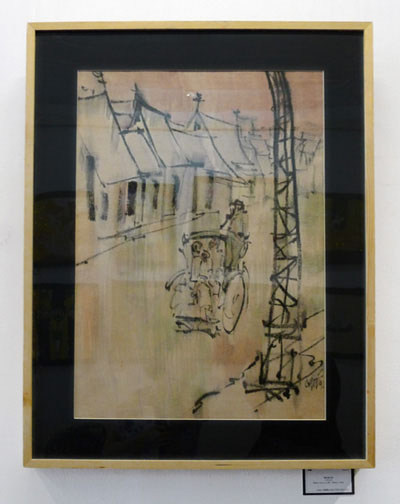
This is an example of Choe’s contribution to silk painting. The medium was previously esteemed for the soft shapes and pale colours that it lends itself to, but Choe’s draughtsmanship overtook tradition and resulted in some scenic sketches of vibrant energy.
The current exhibition does not, strangely enough, give pride of place to some of the spectacular portraits of Vietnamese writers and poets that Choe painted in oil around the year 2000, a few years before his death. The gallery owns a few of these graphically brilliant pieces, drawn with dripped enamel, and coloured in limited harmonies that give plenty of space for the strong black lines to breathe. The exhibition catalogue shows good quality pictures of these paintings, and a couple of the originals can be found on the top floor of the gallery, amongst other semi-permanent displays. They are worth seeking out.
Cristina Nualart is an art practitioner and lecturer at RMIT University Vietnam.
